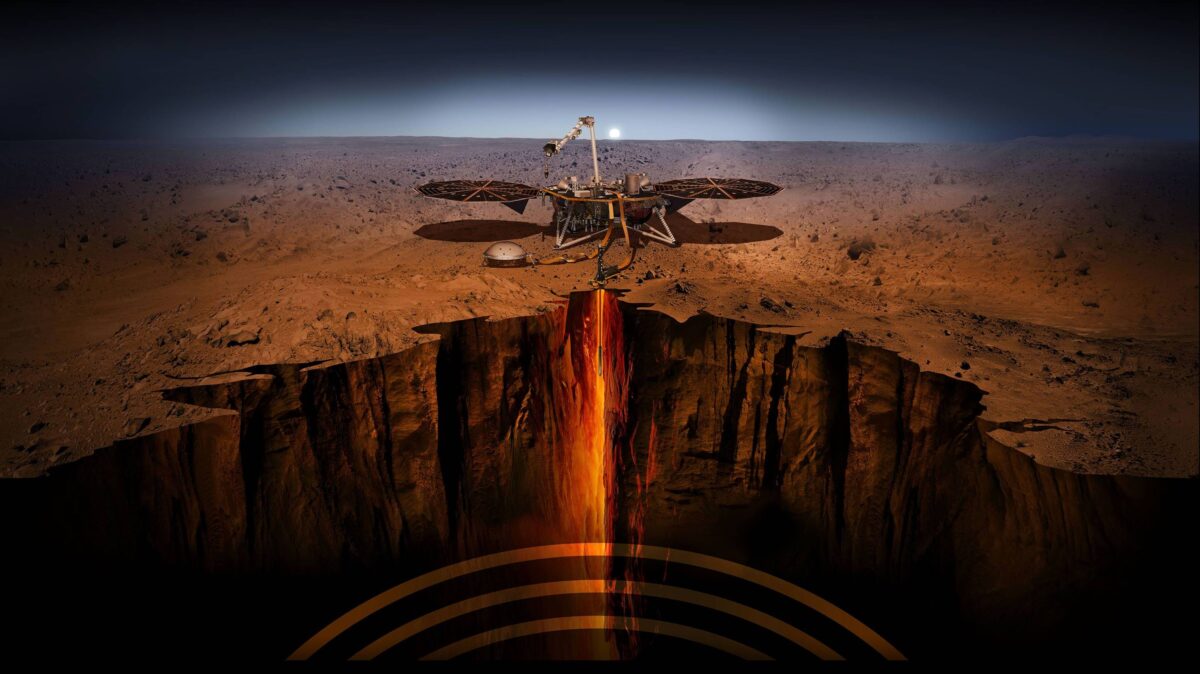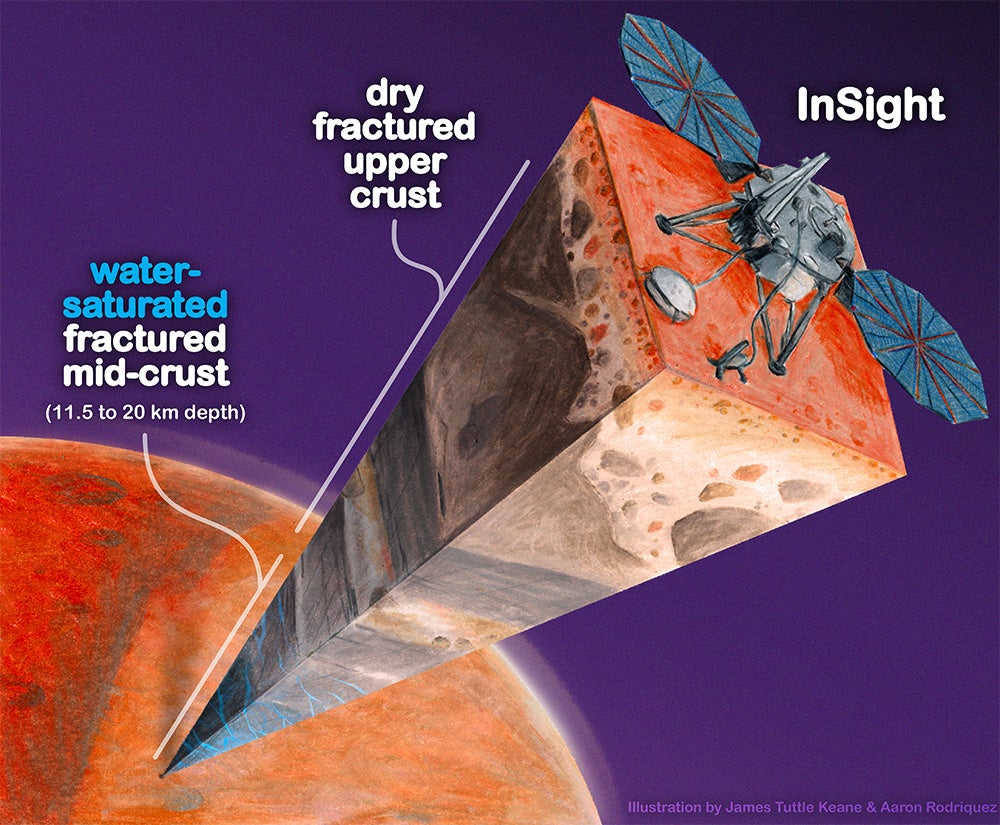
NASA’s Mars InSight lander ended its mission in 2022, but the data it collected has revealed evidence for liquid water deep beneath its landing site. Credit: NASA/JPL-Caltech
Deep beneath the surface of Mars lies a large reservoir of liquid water, according to seismometer data from NASA’s retired InSight lander. The findings, published Aug. 12 in Proceedings of the National Academy of Sciences, hint at sufficient water to fill oceans and globally cover Mars to a depth of over a mile (1 to 2 kilometers).
But the reservoir will be of little help to The Martian’s Mark Watney or other human explorers: It lies in minuscule cracks and pores in rock deep within the planet’s crust between 7.1 miles (11.5 km) and 12 miles (20 km) under the surface.
That means this underground reservoir is unreachable — at least for now. But this study is the best evidence to date that vast reservoirs of martian water — most of which was thought to have evaporated into space billions of years ago — may instead have gone to ground, raising hopes in the search for life.
It also opens a window into the planet’s past, adding to a rich corpus of evidence that billions of years ago water flowed abundantly on Earth’s next-door neighbor. That bygone world was warmer, wetter, and girdled by a thicker atmosphere than the desiccated, subfreezing, and radiation-mauled wasteland of today’s Mars.
To understand how that world disappeared, a fuller understanding of the martian water cycle is critical, says Vashan Wright of the University of San Diego’s Scripps Institution of Oceanography, one of the report’s authors. “A useful starting point is to identify where water is and how much is there.”
Wright and colleagues Michael Manga of the University of California at Berkeley and Matthias Morzfeld of Scripps employed a mathematical model of rock physics, identical to methodologies used on Earth to map underground aquifers and oilfields. Their results suggest InSight’s seismic data is best explained by a layer of fractured igneous rock saturated with liquid water embedded in the middle of the planet’s crust.
“Establishing that there is a big reservoir of liquid water provides some window into what the climate was like or could be like,” says Manga.
A once habitable world
During Mars’ Noachian geological epoch — from 4.1 to 3.7 billion years ago, roughly contemporaneous with the first stirring of life on Earth — an ocean perhaps filled a third of the planet’s northern hemisphere and conditions may have been habitable.
“Mars may have had a hydrological cycle similar to Earth’s, in which groundwater was connected to rivers, lakes, and possibly oceans,” said Wright.
Today, traces of that aqueous past are everywhere: in outflow channels, gullies, dried-up riverbeds, and minerals and rocks that could only have formed in water’s presence.
But impaired by its low gravity, lack of a magnetic field, and the fierce solar wind, much of Mars’ early atmosphere is thought to have escaped into space — along with most of its water. For decades, the only water accounted for on Mars was in the form of ice, at the polar caps and buried underground.

But recent research has questioned whether Mars lost as much water as scientists thought. An analysis of data acquired from several Mars missions published in Science in 2021 suggested that over 30 percent of martian water might remain entrapped in minerals in the planet’s crust. “There is a lot of uncertainty in how much water was lost to space,” Wright says. “But the amount we infer [that has been lost] is much larger than the volume of ice on the surface.”
At the same time, observational evidence has been mounting that Mars harbors a substantial amount of subsurface water — in liquid form. In 2018, researchers analyzing data from Europe’s Mars Express orbiter reported what appeared to be 12-mile-wide (20 km) salty lake situated 0.9 mile (1.5 km) under the south polar ice cap. A follow-up study in 2020 with more advanced techniques bolstered the case and found additional briney areas nearby. And geological evidence from Mars Express hinted at a planetwide groundwater system that flourished 3.5 billion years ago.
Probing deeper
Launched in May 2018, InSight voyaged 301 million miles (484 million km) to Mars, landing the following November on the 1,800-mile-wide (3,000 km) Elysium Planitia, an equator-straddling plain of river valleys, crustal faults, and ancient volcanism. The craft was equipped with an array of instruments and sensors designed to probe Mars’ interior.
InSight’s ultra-sensitive seismometer — the French-built Seismic Experiment for Interior Structure (SEIS) — yielded the data that produced the new results. Capable of detecting vibrations as soft as a breeze, the dome-covered sensor was placed on Mars’ ochre-hued surface by the lander’s robotic arm. Data was gathered from December 2018 until the mission’s end in December 2022, when InSight’s power levels ran low.
The findings rest on Insight’s measurements of the density of the layers of rock beneath the craft and the speed of seismic waves, produced by marsquakes and impacts, as they travel through that rock. But if dynamics of the crust are similar all over Mars, there ought to be more than enough water in this mid-crust reservoir to fill the Red Planet’s ancient oceans, the authors argue.
“From what data we have elsewhere on Mars, there is no clear reason to think the mid-crust elsewhere is much different from beneath InSight,” says Wright. “If there is groundwater below InSight, we would expect groundwater elsewhere too.”
How the water found its way so deep into the crust remains unclear, but its presence is another line of evidence for Mars’ watery past. “The interior of Mars has been cooling over time. If the water is liquid now, it would have been liquid in the past,” Wright said. “To get from the surface to these depths, the shallow crust would also have to be warmer.”
It also raises the possibility that deep beneath the surface, the porous saturated rock teems with microbes. “Water is necessary for life as we know it. It’s certainly true on Earth — deep, deep mines host life, the bottom of the ocean hosts life,” says Manga. “We have identified a place that should, in principle, be able to sustain life.”

